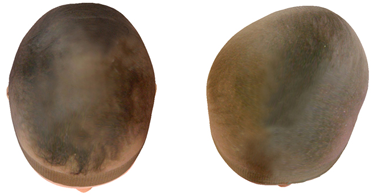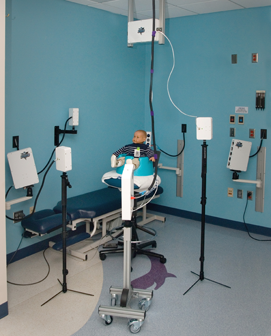Six-month-old infants with deformational plagiocephaly show delays in early motor skills
by Joel Schwarz

Top of the head views of two infant heads show the skull
of a typically developing six-month-old (left) and the irregular
shape caused by deformational plagiocephaly on a baby of the
same age (right). The condition may be related to developmental
delays in infants.

CHDD-affiliated researchers use a multi-camera
system, shown here focused on a doll, to get
three-dimensional imaging of infant skulls to
look for cranial deformations. These can occur
when an infant spends a prolonged amount of
time in one position causing external pressures
to be applied to skull plates.
Until recently deformational plagiocephaly (DP) in infants and young children was only believed to be a cosmetic issue. However new work by research affiliates of the Center on Human Development and Disability (CHDD) indicates that DP may be related to developmental delays, primarily involving motor skills, in six-month-old infants.
The on-going research included the first controlled study that suggests infants who have flattened or asymmetrical heads may be at risk for developmental delays. In addition, the work headed by Mathew Speltz, Ph.D., University of Washington professor of psychiatry and behavioral sciences, director of the Child Psychiatry Outpatient Clinic at Seattle Children's Hospital, and a CHDD affiliate, showed that infants with DP also had mild cognitive and language delays.
The number of children diagnosed with DP has mushroomed in the past two decades since a Back to Sleep campaign was launched in the United States to encourage parents to have their babies sleep on their back to help prevent Sudden Infant Death Syndrome (SIDS). This also coincided with infants spending more time lying on their backs on hard surfaces or in one position while they are in car seats, strollers, infant seats and cribs. "There is no reliable estimate of how many babies have DP, although it has increased remarkably," said Speltz. "Some studies suggest that DP occurred in about one in 300 infants in the l970s, and as high as one in five infants today. In our study 30 percent of the babies in our control group were eventually found to have some degree of DP. Part of the problem is that the diagnosis is very subjective because cranial deformation occurs on a spectrum, with no clear demarcation between normal and abnormal."
Deformational plagiocephaly occurs when the skull plates become deformed as a result of external pressures applied to an infant who spends a prolonged amount of time in one position. This can cause a flat or asymmetrical spot in the infant's skull, with varying degrees of severity and persistence over time."
In his research, Speltz and a team of researchers assessed the neurodevelopment of 235 infants diagnosed with DP who were an average of six months of age and 237 control babies with similar demographic backgrounds but no known history of DP. The infants first had three-dimensional imaging of their heads taken with a multi-camera stereophotogrammetry system and two dysmorphologists, who were unaware of the babies' case or control status, rated their cranial deformation. Controls with previously undetected DP were excluded. The Bayley Scales of Infant Development III were used to measure each infant's cognitive, language, and motor development. These scales measure development from ages one to 36 months and use tasks that typically developing infants can complete. Tasks in the scale become more complex with age, similar to the way IQ test items become more difficult, said Speltz. For infants six months of age and a little older, cognitive skills are assessed by problem-solving tasks such as taking objects in and out of a container or visually tracking a moving object. The examination of language skills begins with an infant's ability to vocalize and repeat sounds. For motor skills, the ability to grab or reach for something or rolling over are checked.
The researchers found only modest delays in language and cognitive development among the DP infants at six months. However, there was a 10-point difference in the motor scores between the two groups, with the DP babies having lower scores. "Ten points is two-thirds of a standard deviation on this test. Given the relatively high incidence of DP this means a large number of babies in the U.S. population may be delayed in motor development. At six-months of age these delays might be seen in such motor skills as rolling from side to side, putting arms out and pushing up on arms, trying to reach up, and trying to crawl," said Speltz.
The research is designed to follow these children up to age three and Speltz has applied for funding to continue tracking them until they are six. "One reason to do this is that the persistence of cranial deformation and associated neurodevelopmental problems is not known. Some children at age six or seven may still have a noticeable cranial flatness or asymmetry. We don't know precisely what happens over time," he said. Speltz is presently analyzing data collected at 18-months of age and preliminary analysis indicates there are statistically and clinically significant differences in both head shape and neurodevelopmental status between children with and without DP.
Speltz emphasized that any link between DP and developmental delay is probably correlational and not causal, and that parents should continue to have babies sleep on their backs. "Supine positioning may lead to motor delay in some infants. But what is most plausible is that most of these infants had pre-existing neuromuscular delays that made them more likely to have flat heads. If this is true, DP may serve as an effective biomarker of neurodevelopmental vulnerability. Mild to moderate motor delays in early infancy are often subtle and not always noticeable to parents, but cranial deformation can be pretty obvious and it may be helpful as an early sign of developmental problems. We know that early intervention is highly effective with motor skills deficits. At the same time we need to continue encouraging parents to place their babies on their back when they put them down to sleep. The data on SIDS is unequivocal that many infant lives have been saved. But when the baby is awake parents should shift the infant to a prone position. We also recommend that pediatricians should pay very close attention to the motor development of infants diagnosed with DP."
The research is funded by the National Institute of Child Health and Human Development and the National Center for Research Resources. Also participating in the research was CHDD affiliate Michael Cunningham, M.D., Ph.D., UW professor of pediatrics, and director of Seattle Children's Hospital Craniofacial Center; Brent Collett, Ph.D., UW assistant professor of psychiatry and behavioral sciences; and Jacqueline Starr, Ph.D., UW associate professor of epidemiology. The six-month study was published earlier this year in the journal Pediatrics.
 Mathew Speltz researches links between flattened or asymmetrical skulls and the risks for developmental delay among infants. Mathew Speltz researches links between flattened or asymmetrical skulls and the risks for developmental delay among infants.
|